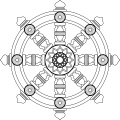Dharmachakra
The dharmachakra (Skt. dharmacakra; P. dhammacakka; T. chos kyi ’khor lo ཆོས་ཀྱི་འཁོར་ལོ; C. falun; J. hōrin; K. pŏmnyun 法輪), or wheel of dharma, is an eight-spoked wheel that traditionally represents the teachings of the Buddha. Each spoke of the wheel symbolizes a branch of the noble eightfold path.[1]
The dharmachakra is one of the earliest symbols of the Buddha's teachings. It has represented the Buddhist dharma since the time of early Buddhism.[2]
It is one of the eight auspicious symbols in Buddhism.[3][4]
History
The Dharmachakra is one of the oldest known Buddhist symbols found in Indian art, appearing with the first surviving post-Indus Valley Civilization Indian iconography in the time of the Buddhist king Ashoka.[2][note 1]
The Buddha is said to have set the dharmachakra in motion when he delivered his first sermon,[5] which is recorded in the Dhammacakkappavattana Sutta. The eight spokes of the wheel represent the Noble Eightfold Path, which the Buddha presented in this sermon.
In Indian mythology, the term chakravartin, or "wheel-turner", was used to described a universal king or monarch.[5][6] The chakravatartin was said to possess "a magical wheel that rolled around the world, bringing the land's it entered under the king's domain."[7] Buddhism adopted the wheel symbol to represent the teachings of the Buddha; hence, teaching the Buddha-dharma is referred to as "turning the wheel of the dharma."
One aspect of the dharmachakra is that it has the ability to cut through all obstacles and illusions.[6]
Pre-Buddhist history
The wheel is also the main attribute of Vishnu, the Vedic god.[6] Madhavan and Parpola note that the Chakra sign appears frequently in Indus Valley civilization , on several seals.[8] Notably, in a sequence of ten signs on the Dholavira signboard, four are the chakra.[9]
Gallery
Wat Phothivihan, Tumpat, Kelantan
The flag of the former Kingdom of Sikkim featured a version of the Dharmachakra
The insignia for Buddhist chaplains in the United States Armed Forces.
Unicode Symbol
Unicode Symbol: ☸ (U+2638: Wheel Of Dharma)
Notes
References
- ↑
 Buswell & Lopez 2014, s.v. Dharmacakra
Buswell & Lopez 2014, s.v. Dharmacakra
- ↑ 2.0 2.1 2.2 Grünwedel 1901, p. 67.
- ↑ "Buddhist Symbols". Ancient-symbols.com. Retrieved 22 June 2018.
- ↑ Goetz 1964, p. 52.
- ↑ 5.0 5.1 Pal 1986, p. 42.
- ↑ 6.0 6.1 6.2 Beer 2003, p. 14.
- ↑
 Buswell & Lopez 2014, s.v. Dharmacakra
Buswell & Lopez 2014, s.v. Dharmacakra
- ↑ The Ancient Indus Valley: New Perspectives By Jane McIntosh. Page :377
- ↑ The Ancient Indus Valley: New Perspectives By Jane McIntosh. Page :377
Sources
- Anthony, David W. (2007), The Horse The Wheel and Language. How Bronze-Age Riders From The Eurasian Steppes Shaped The Modern World, Princeton University Press
- Beer, Robert (2003), The Handbook of Tibetan Buddhist Symbols, Serindia Publications, Inc., ISBN 9781932476033
 Buswell, Robert E.; Lopez, Donald S. (2014), The Princeton Dictionary of Buddhism, Princeton University
Buswell, Robert E.; Lopez, Donald S. (2014), The Princeton Dictionary of Buddhism, Princeton University- Goetz, Hermann (1964), The art of India: five thousand years of Indian art., Crown
- Grünwedel, Albert; Gibson, Agnes C.; Burgess, James (1901), Buddhist art in India, Bernard Quaritch
- Harrison, Jane Ellen (2010) [1912], Themis: A Study of the Social Origins of Greek Religion, Cambridge University Press
- Pal, Pratapaditya (1986), Indian Sculpture: Circa 500 B.C.-A.D. 700, University of California Press
External links
 chos_kyi_'khor_lo, Rangjung Yeshe Wiki
chos_kyi_'khor_lo, Rangjung Yeshe Wiki- Dharmachakra (Wikipedia)




.jpg/120px-003_Dhammacakka_Wheel_(9140985559).jpg)
.svg/120px-Flag_of_Sikkim_(1967-1975).svg.png)
.svg/120px-Dharmacakra_flag_(Thailand).svg.png)

.svg/120px-Dharmachakra%2c_withprint_(en).svg.png)